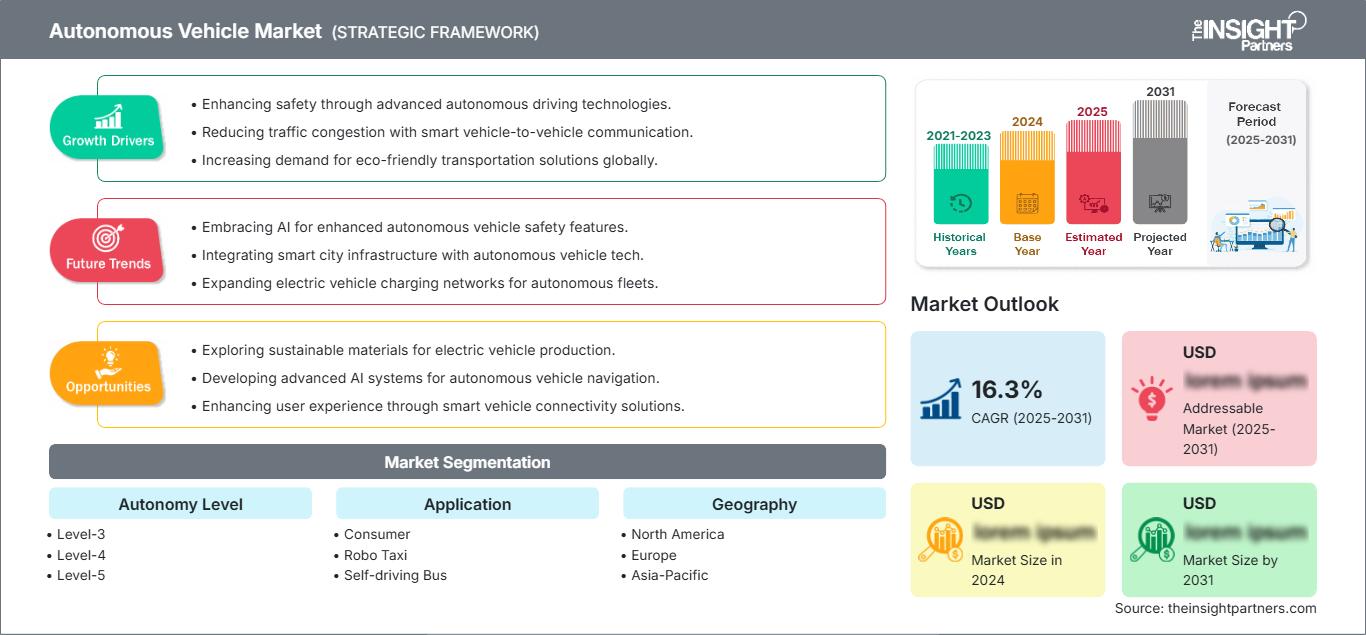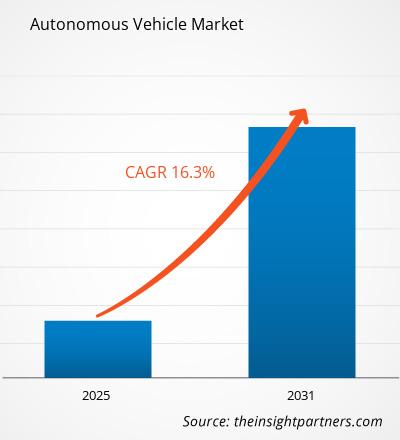Der Markt für autonome Fahrzeuge wird voraussichtlich zwischen 2025 und 2031 eine durchschnittliche jährliche Wachstumsrate (CAGR) von 16,3 % verzeichnen, wobei die Marktgröße von XX Millionen US-Dollar im Jahr 2024 auf XX Millionen US-Dollar im Jahr 2031 anwachsen wird.
Der Bericht ist nach Autonomiestufe (Stufe 3, Stufe 4, Stufe 5) und Anwendung (Verbraucher, Robo-Taxi, selbstfahrender Bus, Ride Hail, Ride Share) segmentiert. Die globale Analyse ist weiter nach Regionen und wichtigen Ländern aufgeschlüsselt. Der Bericht bietet den Wert in USD für die obige Analyse und Segmente.
Zweck des Berichts
Der Bericht „Markt für autonome Fahrzeuge“ von The Insight Partners zielt darauf ab, die aktuelle Situation und das zukünftige Wachstum sowie die wichtigsten treibenden Faktoren, Herausforderungen und Chancen zu beschreiben. Dadurch erhalten verschiedene Geschäftsinteressenten Einblicke, beispielsweise:
- Technologieanbieter/-hersteller: Um die sich entwickelnde Marktdynamik zu verstehen und die potenziellen Wachstumschancen zu kennen, sodass sie fundierte strategische Entscheidungen treffen können.
- Investoren: Um eine umfassende Trendanalyse hinsichtlich der Marktwachstumsrate, der finanziellen Marktprognosen und der Chancen entlang der Wertschöpfungskette durchzuführen.
- Regulierungsbehörden: Um Richtlinien und Überwachungsaktivitäten auf dem Markt zu regulieren, mit dem Ziel, Missbrauch zu minimieren, das Vertrauen der Investoren zu wahren und die Integrität und Stabilität des Marktes aufrechtzuerhalten.
Marktsegmentierung für autonome Fahrzeuge: Autonomiestufe
- Stufe 3
- Stufe 4
- Stufe 5
Anwendung
- Verbraucher
- Robo-Taxi
- Selbstfahrender Bus
- Mitfahrgelegenheit
- Mitfahrgelegenheit
Sie erhalten kostenlos Anpassungen an jedem Bericht, einschließlich Teilen dieses Berichts oder einer Analyse auf Länderebene, eines Excel-Datenpakets sowie tolle Angebote und Rabatte für Start-ups und Universitäten.
Markt für autonome Fahrzeuge: Strategische Einblicke

- Holen Sie sich die wichtigsten Markttrends aus diesem Bericht.Dieses KOSTENLOSE Beispiel umfasst Datenanalysen, die von Markttrends bis hin zu Schätzungen und Prognosen reichen.
Wachstumstreiber für autonome Fahrzeuge
- Technologische Fortschritte in KI und maschinellem Lernen: Der kontinuierliche Fortschritt in den Bereichen KI und maschinelles Lernen treibt den Markt für autonome Fahrzeuge (AV) voran. Diese Fortschritte ermöglichen es AVs, Sensordaten besser zu verarbeiten, Entscheidungen in Echtzeit zu treffen und die Sicherheit zu erhöhen. KI ermöglicht es Fahrzeugen, ihre Umgebung immer genauer zu interpretieren, was die Navigation, Kollisionsvermeidung und das Verkehrsmanagement verbessert. Mit der Weiterentwicklung dieser Technologien steigt die Zuverlässigkeit selbstfahrender Autos, was das Vertrauen und die Akzeptanz der Verbraucher stärkt und das Marktwachstum beschleunigt.
- Verstärkter Fokus auf Verkehrssicherheit und Unfallverhütung: Autonome Fahrzeuge werden menschliche Fehler, die für die meisten Verkehrsunfälle verantwortlich sind, reduzieren. Durch den Einsatz von Sensoren, Kameras und fortschrittlichen Algorithmen können AVs Gefahren vorhersehen und schneller reagieren als menschliche Fahrer. Dieses Versprechen, Unfälle deutlich zu reduzieren und Leben zu retten, hat die Aufmerksamkeit von Regulierungsbehörden und Verbrauchern geweckt. Regierungen und Versicherungsunternehmen unterstützen zunehmend autonome Fahrzeugtechnologien, um die Verkehrssicherheit zu verbessern und so das Marktwachstum voranzutreiben.
- Staatliche Unterstützung und regulatorische Rahmenbedingungen: Regierungen weltweit investieren massiv in autonome Fahrzeugtechnologien, um zukünftige Transportsysteme zu gestalten. Es werden Richtlinien, Zuschüsse und Anreize eingeführt, um die Entwicklung und Erprobung autonomer Fahrzeuge zu fördern. Darüber hinaus arbeiten Regulierungsbehörden aktiv an der Schaffung von Rahmenbedingungen, die Sicherheit, Cybersicherheit und ethische Standards für selbstfahrende Autos gewährleisten. Diese staatliche Unterstützung sowie klare regulatorische Richtlinien stärken das Marktvertrauen und beschleunigen die Einführung autonomer Fahrzeuge auf den Straßen.
Zukünftige Trends im Markt für autonome Fahrzeuge
- Aufstieg elektrischer autonomer Fahrzeuge: Die Konvergenz von Elektrofahrzeugen (EV) und autonomen Fahrzeugtechnologien ist ein neuer Trend. Elektrofahrzeuge, die mit sauberer Energie betrieben werden, stehen im Einklang mit dem Streben nach Nachhaltigkeit und umweltfreundlichem Transport. Da Automobilhersteller autonome Systeme für Elektrofahrzeuge entwickeln, steigt die Nachfrage nach elektrischen selbstfahrenden Autos. Dieser Trend wird durch Umweltrichtlinien, die Präferenz der Verbraucher für umweltfreundliche Verkehrsmittel und die zunehmende Kosteneffizienz von Elektrofahrzeugen gefördert. Die Umstellung auf elektrische autonome Fahrzeuge dürfte in den kommenden Jahren zu einem deutlichen Marktwachstum führen.
- Integration mit Mobility-as-a-Service (MaaS): Ein weiterer Trend, der den Markt für autonome Fahrzeuge prägt, ist die zunehmende Integration von autonomen Fahrzeugen in Mobility-as-a-Service (MaaS)-Plattformen. Verbraucher bevorzugen zunehmend geteilte On-Demand-Transportmodelle, reduzieren den Autobesitz und nutzen autonome Fahrzeuge für Mitfahrgelegenheiten, Shuttle-Dienste und die Anbindung auf der letzten Meile. MaaS-Plattformen kombinieren Transportoptionen wie selbstfahrende Autos, Busse und Fahrräder zu einem nahtlosen Service. Dieser Trend trägt zur Ausweitung autonomer Fahrzeuge als zentraler Bestandteil des städtischen Verkehrsökosystems bei.
Marktchancen für autonome Fahrzeuge
- Entwicklung der AV-Infrastruktur: Der weltweite Vorstoß in Richtung Smart Cities und vernetzter Infrastruktur bietet erhebliche Chancen für autonome Fahrzeuge. Intelligente Straßensysteme mit fortschrittlicher Sensorik, Verkehrsmanagement und Fahrzeug-zu-Infrastruktur (V2I)-Kommunikation können die Sicherheit und Effizienz autonomer Fahrzeuge verbessern. Diese Entwicklungen schaffen ein förderliches Umfeld für den Einsatz autonomer Fahrzeuge und können die Betriebskosten senken, die Leistung verbessern und die Zahl der Unfälle reduzieren. Da Regierungen in intelligente Infrastruktur investieren, steht dem Markt für autonome Fahrzeuge ein rasantes Wachstum bevor.
- Partnerschaften und Kooperationen im AV-Ökosystem: Strategische Partnerschaften zwischen Automobilherstellern, Technologieunternehmen und Forschungseinrichtungen bieten eine wertvolle Gelegenheit, Innovationen im Bereich autonomer Fahrzeuge voranzutreiben. Unternehmen aus der Automobil- und Technologiebranche können ihre Expertise in den Bereichen KI, Sensorik, Datenanalyse und Fahrzeugdesign gegenseitig nutzen. Kooperationen können die Entwicklung sicherer, zuverlässigerer und kostengünstiger autonomer Fahrzeuge vorantreiben. Dieser kollaborative Ansatz fördert Innovationen, beschleunigt die Markteinführung und hilft Unternehmen, die finanzielle Belastung der AV-Entwicklung zu teilen.
Regionale Einblicke in den Markt für autonome Fahrzeuge
Die Analysten von The Insight Partners haben die regionalen Trends und Faktoren, die den Markt für autonome Fahrzeuge im Prognosezeitraum beeinflussen, ausführlich erläutert. In diesem Abschnitt werden auch die Marktsegmente und die geografische Lage autonomer Fahrzeuge in Nordamerika, Europa, im asiatisch-pazifischen Raum, im Nahen Osten und Afrika sowie in Süd- und Mittelamerika erörtert.
Umfang des Marktberichts zum autonomen Fahrzeug
| Berichtsattribut | Einzelheiten |
|---|---|
| Marktgröße in 2024 | US$ XX million |
| Marktgröße nach 2031 | US$ XX Million |
| Globale CAGR (2025 - 2031) | 16.3% |
| Historische Daten | 2021-2023 |
| Prognosezeitraum | 2025-2031 |
| Abgedeckte Segmente |
By Autonomiestufe
|
| Abgedeckte Regionen und Länder | Nordamerika
|
| Marktführer und wichtige Unternehmensprofile |
|
Dichte der Marktteilnehmer für autonome Fahrzeuge: Auswirkungen auf die Geschäftsdynamik verstehen
Der Markt für autonome Fahrzeuge wächst rasant. Die steigende Nachfrage der Endnutzer ist auf Faktoren wie veränderte Verbraucherpräferenzen, technologische Fortschritte und ein stärkeres Bewusstsein für die Produktvorteile zurückzuführen. Mit der steigenden Nachfrage erweitern Unternehmen ihr Angebot, entwickeln Innovationen, um den Bedürfnissen der Verbraucher gerecht zu werden, und nutzen neue Trends, was das Marktwachstum weiter ankurbelt.

- Holen Sie sich die Markt für autonome Fahrzeuge Übersicht der wichtigsten Akteure
Wichtige Verkaufsargumente
- Umfassende Abdeckung: Der Bericht analysiert umfassend Produkte, Dienstleistungen, Typen und Endnutzer des Marktes für autonome Fahrzeuge und bietet einen ganzheitlichen Überblick.
- Expertenanalyse: Der Bericht basiert auf dem umfassenden Verständnis von Branchenexperten und Analysten.
- Aktuelle Informationen: Der Bericht gewährleistet Geschäftsrelevanz durch die Berichterstattung über aktuelle Informationen und Datentrends.
- Anpassungsoptionen: Dieser Bericht kann an spezifische Kundenanforderungen angepasst werden und passt sich so optimal an die Geschäftsstrategien an.
Der Forschungsbericht zum Markt für autonome Fahrzeuge kann daher dazu beitragen, die Branchensituation und die Wachstumsaussichten zu entschlüsseln und zu verstehen. Obwohl es einige berechtigte Bedenken geben mag, überwiegen die Vorteile dieses Berichts tendenziell die Nachteile.
- Historische Analyse (2 Jahre), Basisjahr, Prognose (7 Jahre) mit CAGR
- PEST- und SWOT-Analyse
- Marktgröße Wert/Volumen – Global, Regional, Land
- Branchen- und Wettbewerbslandschaft
- Excel-Datensatz
Aktuelle Berichte
Verwandte Berichte
Erfahrungsberichte
Grund zum Kauf
- Fundierte Entscheidungsfindung
- Marktdynamik verstehen
- Wettbewerbsanalyse
- Kundeneinblicke
- Marktprognosen
- Risikominimierung
- Strategische Planung
- Investitionsbegründung
- Identifizierung neuer Märkte
- Verbesserung von Marketingstrategien
- Steigerung der Betriebseffizienz
- Anpassung an regulatorische Trends




















 Kostenlose Probe anfordern für - Markt für autonome Fahrzeuge
Kostenlose Probe anfordern für - Markt für autonome Fahrzeuge